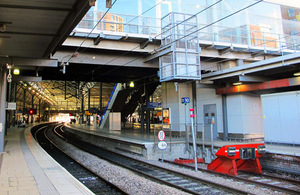Plans for £38 billion investment in railways unveiled
Millions of passengers across the country will benefit from the £38 billion 5-year plan to transform the railways.

A route-by-route plan for how an ambitious 5-year programme to invest £38 billion in railways will take shape has been unveiled today (31 March 2014).
Millions of passengers across the country will benefit from the plan to transform the railways, giving passengers more trains, more seats, reduced congestion and bigger, better stations.
The 5-year plan for Network Rail’s new funding period, which starts on 1 April 2014, will target the busiest parts of Britain’s rail network, providing a significant boost to the economy.
Transport Secretary Patrick McLoughlin said:
A key part of this government’s long term economic plan is investing in world class infrastructure.
That is why we are putting record amounts of government funding into our railways over the next 5 years.
That investment will generate growth, create jobs and boost business while delivering faster journeys, greater comfort and better punctuality for passengers across the UK.
The Chief Secretary to the Treasury, Danny Alexander said:
After years of neglect, the UK’s energy, road, rail, flood defence, communications and water infrastructure needs renewal, and as I set out in December, you name it, this government is building it.
The government was the first to set out a clear, long term plan for infrastructure and we’re delivering it.
This £38 billion programme starting this week will involve the largest modernisation of the railways since Victorian times, funding projects across the whole of the UK and building on the work that is already underway to give us the modern efficient transport infrastructure that we need to compete.
Find out what else the government is doing to support and grow the UK economy.
Key features of the plan for England and Wales include:
- the Northern Hub: transforming rail across the north of England with capacity for hundreds more trains and 44 million more passengers, with the potential to boosting the regional economy with thousands more jobs
- the Thameslink programme: increasing to 24 trains per hour at peak times each way through the centre of London, freeing up capacity on the capital’s transport network
- Over 850 miles of railway electrification: including the Great Western Main Line, Midland Main Line and across the north and north west of England, bringing greener, more frequent and more reliable journeys for millions of passengers
- A new, electrified railway linking the Great Western, West Coast and Midland main lines, connecting Oxford with Bedford and Milton Keynes as part of the East-West Rail project
- Transformed stations at Birmingham New Street, Manchester Victoria, Bristol Temple Meads and London Bridge
Improving passenger, public and workforce safety is a central part of the plans, which include the closure of a further 500 level crossings on top of almost 800 closed since 2010.
In addition, 7,000 kilometres of track and nearly 6,000 sets of points will be renewed or refurbished and 7,000 kilometres of fencing and almost 300,000 square metres of platforms at stations will be replaced or renewed.
Network Rail has also committed to making even more trains run on time. By 2019, it has agreed to increase punctuality levels to 92.5% across England and Wales while running more trains and carrying more people than ever before.
Rail media enquiries
Media enquiries 0300 7777878
Switchboard 0300 330 3000